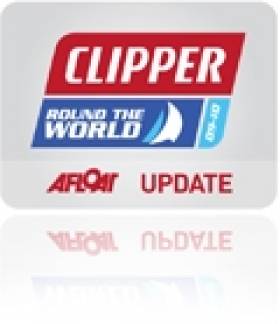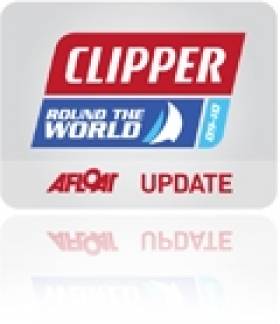Displaying items by tag: Round the World Yacht Race
More than 360 adventurers travelled from all over the globe to attend the crew allocation event on Saturday 30 April to discover which of the ten teams competing in Clipper 11-12 they will represent. Three-quarters of the 489 men and women who will be taking part in this gruelling challenge of a lifetime came together to meet their skippers and new team mates, travelling from as far afield as Singapore, Queensland in Australia, Finland, New York and Chile, as well as Derry-Londonderry. Among them were those who will represent the UK City of Culture 2013.
Each of the teams is led by a professional skipper and taking charge of Derry-Londonderry is Mark Light, who took his turn at the podium to read out the names of his 52-strong crew. The race is split into eight legs and crew can sign up to compete in one or more of the individual legs or take on the big one – a full circumnavigation of the globe. Around 40 per cent of the crew who take part in the race have never sailed before embarking on their pre-race training.
Amongst Derry-Londonderry's crew are 12 people from the city, including round the world crew member, John Harkin, and his daughter, Jodie, who will race on the final leg from New York, via her home town to the finish line on the south coast of England.
John says, "I'm really delighted and my daughter's on the same boat as well so it's excellent news. It's going to be a dream come true for me. She's sailed with me all her life – she's sailed against me many times, too, so it'll be nice for her to be sailing with me!
"When I come back into Derry having sailed around the world, that'll be the biggest thing in my lifetime, it's tremendous. The boat is visiting Derry-Londonderry for a naming ceremony in a few weeks' time and I think that will be a big buzz. It's a beautiful city and it'll be a very warm welcome there."
Also in the crew are four from just across the border in Donegal and five others from the Republic of Ireland, as well as people from nine other nationalities, demonstrating the international and multi-cultural nature of the race.
The crew allocation event is much anticipated among those who have signed up to take part. This is where the reality of their participation in the race truly begins to kick in; with a skipper in place, team strategies start to take shape, roles are assigned to the crew and, with 92 days to go until the race start, the countdown is on.
The race is contested by ten identical stripped-down 68-foot racing yachts, each sponsored by a city, region or country. Already confirmed for Clipper 11-12 are the Keppel Corporation-sponsored Singapore and, representing China's Olympic sailing city, Qingdao, both of which will take part for the fourth time. Returning for a second time is Visit Finland, backed by the Finnish Tourist Board, and, making their debut alongside Derry-Londonderry, is De Lage Landen, sponsored by the global provider of asset-based financing programmes of the same name and which will race under the Dutch flag. The names of the five remaining yachts will be revealed in the coming weeks ahead of the start of the race on 31 July 2011.
The Clipper Race was founded by sailing legend, Sir Robin Knox-Johnston, the first man to sail solo and non-stop around the world, and this will be the eighth time his teams of amateur sailors will circumnavigate the planet, taking the number of people who have taken part in the event to almost 3,000.
Addressing the massed crews Sir Robin said, "It's a big day for you today because you're going to find out who you're going to share your life with for the next year. And it's not just sharing your life, it's sharing an adventure. Your lives are going to be dependent on your fellow crew members. Today you'll know what team you're going to be in and these are the people you have to live with and work with for the next year. These are the people you have to trust. It's the team that will be all important in this race.
"Also know that you've only got one life so why not paint it in bright colours? Don't use pastel shades. Make the most of it – get out there, throw yourselves into it! You will come away from this with friends for life."
Derry-Londonderry and her skipper and crew will be visiting the city as part of the Foyle Days festival from 20-22 May 2011.
Mark, 39, is among the line-up of international sailors who have been appointed to the prestigious and challenging position following a rigorous selection process and says, "I am absolutely delighted to have got the job. It didn't sink in initially when I got the phone call but then the emails started coming through and it's now all very real. It's amazing – a great feeling!"
Derry-Londonderry's participation will form the centrepiece of the campaign leading up to the city's celebrations as UK City of Culture 2013.
Mark says, "When I got the job I had in mind that I would like to skipper the Irish entry so it's great to have been appointed to lead the Derry-Londonderry team. I think Northern Ireland's a fantastic place and it's great that our stopover is one of the last of the race so we have it as a great motivator all the way around."
Derry-Londonderry is one of ten internationally-sponsored entries in Clipper 11-12. They include Singapore, Chinese entry, Qingdao, and De Lage Landen which will race under the Dutch flag. The Clipper Race is the only global ocean race open to everyone, regardless of background and sailing ability and is the longest in the world. Almost 500 people from 40 nationalities and more than 250 different professions will step outside their comfort zone to race a stripped down, 68-foot yacht 40,000 miles around the world.
"I believe the whole concept of the Clipper Race is brilliant," says Mark. "Making ocean sailing accessible to anybody and providing the challenge and platform on which to literally change people's lives is very special."
He continues, "Being able to lead a crew around the world in a yacht race, for me, takes everything to the next level. It will be so satisfying to watch a group of people put together randomly at first, progress with lots of hard work and training and evolve into a highly competitive race team and group of very accomplished offshore sailors. I will be very proud to carry out that job."
Originally from Gloucestershire, Mark now lives on the Isle of Wight and hopes to celebrate his 40th birthday racing a yacht to victory somewhere in the Southern Ocean. Introduced to sailing in his late 20s he learned to sail dinghies on a lake. Once bitten by the sailing bug he took the plunge, left his job as a mechanical and production engineer and studied full time for the sailing qualifications that would allow him to turn his passion into a career. Now an experienced senior instructor with many ocean crossings to his name, he is most looking forward to racing across the Pacific Ocean – and arriving in his team's home port, Derry-Londonderry, at the end of the final transatlantic stage.
"I am looking forward to the whole race as every leg will no doubt bring very different challenges but there are definitely sections I am looking forward to specifically. The leg I am most looking forward to is crossing the greatest ocean on the planet – the mighty Pacific – but the stopover I am looking forward to most is of course, Derry-Londonderry. Sailing down the River Foyle into the heart of the City of Culture to a fabulous reception is going to be unbeatable!"
The Clipper Race celebrates its 15th anniversary this year, the first edition having been run in 1996. It was established by legendary yachtsman, Sir Robin Knox-Johnston who, in 1969, became the first man to sail solo and non-stop around the world. He wanted to make ocean racing available to everyone, regardless of nationality or background, and since that first race almost 3,000 ordinary people have taken the opportunity to step outside of their comfort zone and do something truly extraordinary by taking on nature in the raw and racing around the world under sail. More than 5,000 more have been introduced to sailing through the Clipper Training programme.
Sir Robin comments, "Leading a team in a race around the world is one of the hardest and most challenging jobs that any skipper could ever undertake and we're confident Mark is up to this challenge. He has been through a lengthy and rigorous selection process and we have chosen a group of ten exceptional individuals as our race skippers. They all have the ability to draw the line between competitiveness and safety while, at the same time, motivating the crew to retain their focus during races lasting several weeks at a time, whether it be through roaring gales and towering seas or the frustration of tricky calm spells."
Followers of the Clipper 11-12 Round the World Yacht Race can look forward to some exciting and exhilarating racing when the event gets underway this August. During the 40,000-mile race the fleet will stop at 15 ports around the world before arriving back in the UK in July 2012. For the first time the route includes an extra leg that will take the fleet from the west coast of Australia rounding Cape Leeuwin en route to New Zealand and then on to Australia's east coast.
The search is already underway for suitably qualified men and women to follow in the footsteps of these ten skippers in the next edition of the race which will start in 2013 and will be raced on the brand new fleet of 70-foot yachts that have been specially commissioned. Skippers wishing to register their interest in applying for one of the most prestigious positions in sailing should email [email protected].






























































